Dorsal hippocampal N-methyl-D-aspartate glutamatergic and δ-opioidergic systems modulate anxiety behaviors in rats in a noninteractive manner
- PMID: 22005157
- PMCID: PMC11916614
- DOI: 10.1016/j.kjms.2011.06.011
Dorsal hippocampal N-methyl-D-aspartate glutamatergic and δ-opioidergic systems modulate anxiety behaviors in rats in a noninteractive manner
Abstract
The present study aimed to investigate the effects of N-methyl-d-aspartate (NMDA)-type glutamate receptor agonist, NMDA, on anxiety-like behavior induced by δ-opioid receptor agents in rats, using the elevated plus maze instrument. The dorsal hippocampus (CA1) is known to play an important role in anxiety formation and modulation. Bilateral administration of different doses of δ-opioid receptor agonist, [d-pen2,5] enkephalin acetate hydrate (1 μg/rat, 2 μg/rat, 5 μg/rat, and 10 μg/rat; 1 μL/rat; 0.5 μL/rat in each side), into CA1 area induced an anxiolytic-like effect, demonstrated by substantial increases in the percent of open arm time (OAT%) and percent of open arm entries (OAE%). Intra-CA1 injection of different doses of δ-opioid receptor antagonist, naltrindole hydrochloride (0.25 μg/rat, 0.5 μg/rat, 1 μg/rat, and 2 μg/rat), produced significant anxiogenic-like behavior. Furthermore, intra-CA1 administration of NMDA glutamate receptor agonist, NMDA (0.125 μg/rat, 0.25 μg/rat, 0.5 μg/rat, and 0.75 μg/rat), increased the OAT% and OAE%, indicating anxiolytic-like behavior. However, administration of different doses of NMDA glutamatergic antagonist, MK801 (0.125 μg/rat, 0.25 μg/rat, 0.5 μg/rat, and 1μg/rat), showed no significant effect on the OAT% but decreased the OAE% significantly. The ineffective dose of NMDA (0.125 μg/rat), when coadministered with enkephalin (1 μg/rat, 2 μg/rat, 5 μg/rat, and 10 μg/rat), did not decrease the anxiety behavior significantly. An effective dose of NMDA (0.5 μg/rat), in combination with different doses of naltrindole hydrochloride (0.25 μg/rat, 0.5 μg/rat, 1 μg/rat, and 2 μg/rat), demonstrated no significant interaction with the OAT%, OAE%, and locomotor activity. These results suggest that CA1 δ-opioid and NMDA glutamatergic systems modulate anxiety behaviors in a noninteractive manner.
Copyright © 2011. Published by Elsevier B.V.
Figures
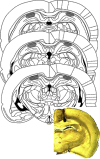
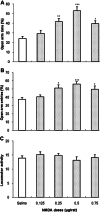

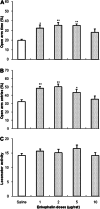
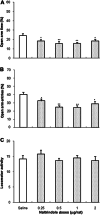
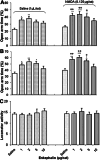

Similar articles
-
Dorsal hippocampal opioidergic system modulates anxiety-like behaviors in adult male Wistar rats.Psychiatry Clin Neurosci. 2010 Dec;64(6):634-41. doi: 10.1111/j.1440-1819.2010.02143.x. Epub 2010 Oct 28. Psychiatry Clin Neurosci. 2010. PMID: 21029249
-
Dopaminergic system in CA1 modulates MK-801 induced anxiolytic-like responses.Pharmacol Biochem Behav. 2012 Nov;103(1):102-10. doi: 10.1016/j.pbb.2012.07.016. Pharmacol Biochem Behav. 2012. PMID: 22885281
-
Involvement of the CA1 GABAA receptors in MK-801-induced anxiolytic-like effects: an isobologram analysis.Behav Pharmacol. 2014 Jun;25(3):197-205. doi: 10.1097/FBP.0000000000000037. Behav Pharmacol. 2014. PMID: 24710315
-
The effect of 5-HT4 serotonin receptors in the CA3 hippocampal region on D-AP5-induced anxiolytic-like effects: Isobolographic analyses.Behav Brain Res. 2021 Jan 15;397:112933. doi: 10.1016/j.bbr.2020.112933. Epub 2020 Sep 28. Behav Brain Res. 2021. PMID: 32991927
-
Role of ventral hippocampal GABA(A) and NMDA receptors in the anxiolytic effect of carbamazepine in rats using the elevated plus maze test.Pharmacology. 2009;84(6):356-66. doi: 10.1159/000256666. Epub 2009 Nov 11. Pharmacology. 2009. PMID: 19907194
Cited by
-
The role of glutamatergic pathway between septum and hippocampus in the memory formation.EXCLI J. 2013 Jan 21;12:41-51. eCollection 2013. EXCLI J. 2013. PMID: 27231475 Free PMC article. Review.
-
Long-term NMDAR antagonism correlates reduced astrocytic glutamate uptake with anxiety-like phenotype.Front Cell Neurosci. 2015 Jun 3;9:219. doi: 10.3389/fncel.2015.00219. eCollection 2015. Front Cell Neurosci. 2015. PMID: 26089779 Free PMC article.
-
Altered cognition and anxiety in adolescent offspring whose mothers underwent different-pattern maternal sleep deprivation, and cognition link to hippocampal expressions of Bdnf and Syt-1.Front Behav Neurosci. 2022 Dec 8;16:1066725. doi: 10.3389/fnbeh.2022.1066725. eCollection 2022. Front Behav Neurosci. 2022. PMID: 36570704 Free PMC article.
-
Preclinical animal anxiety research - flaws and prejudices.Pharmacol Res Perspect. 2016 Mar 8;4(2):e00223. doi: 10.1002/prp2.223. eCollection 2016 Apr. Pharmacol Res Perspect. 2016. PMID: 27069634 Free PMC article. Review.
-
Cross state-dependency of learning between tramadol and MK-801 in the mouse dorsal hippocampus: involvement of nitric oxide (NO) signaling pathway.Psychopharmacology (Berl). 2018 Jul;235(7):1987-1999. doi: 10.1007/s00213-018-4897-5. Epub 2018 Apr 21. Psychopharmacology (Berl). 2018. PMID: 29679289
References
-
- File S., Kenny P., Cheeta S.. The role of the dorsal hippocampal serotonergic and cholinergic systems in the modulation of anxiety. Pharmacol Biochem Behav. 2000; 66: 65–72. - PubMed
-
- Ozawa S., Kamiya H., Tsuzuki K.. Glutamate receptors in the mammalian central nervous system. Prog Neurobiol. 1998; 54: 581–618. - PubMed
-
- Guimarães F., Carobrez A., Aguiar J., Graeff F.. Anxiolytic effect in the elevated plus‐maze of the NMDA receptor antagonist AP7 microinjected into the dorsal periaqueductal grey. Psychopharmacology. 1991; 103: 91–94. - PubMed
-
- Zarrindast M., Babapoor‐Farrokhran S., Rezayof A.. Involvement of opioidergic system of the ventral hippocampus, the nucleus accumbens or the central amygdala in anxiety‐related behavior. Life Sci. 2008; 6: 23–24. - PubMed
MeSH terms
Substances
LinkOut - more resources
Full Text Sources
Medical
Miscellaneous

